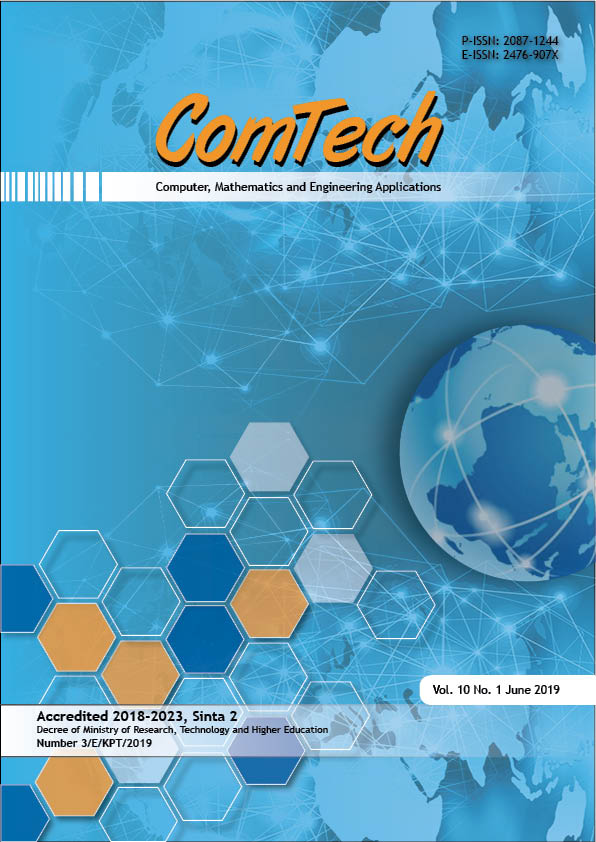Maximality on Construction of Ternary Cross Bifix Free Code
DOI:
https://doi.org/10.21512/comtech.v10i1.4716Keywords:
maximality, construction, ternary cross bifix free codeAbstract
The purpose of this research was to show that ternary cross bifix free code CBFS3(2m+1) and CBFS3(2m+2) achieved the maximum for every natural number m. This research was a literature review. A cross bifix free codes was constructed by using Dyck path method which achieved the maximality, that was non-expandable on binary set sequences for appropriate length. This result is obtained by partitioning members of CBFS3(2m+1) and CBFS3(2m+2) and comparing them with the maximality of CBFS2(2m+1) and CBFS2(2m+2). For small length 3, the result also shows that the code CBFS3(3) is optimal.
Plum Analytics
References
Affaf, M. (2018). Kemaksimalan kode cross bifix bebas. In Seminar Nasional Pendidikan Matematika Ahmad Dahlan (Vol. 6).
Affaf, M., & Ulum, Z. (2017a). Konstruksi kode cross bifix bebas ternair untuk panjang ganjil. In Prosiding SI MaNIs (Seminar Nasional Integrasi Matematika dan Nilai-Nilai Islami) (Vol. 1, No. 1, pp. 1-5).
Affaf, M., & Ulum, Z. (2017b). Konstruksi kodecross bifix bebas ternari berpanjang genap untuk mengatasi masalah sinkronisasi frame. JIKO (Jurnal Informatika dan Komputer), 2(2), 109-116.
Bajic, D. (2007). On construction of cross-bifix-free kernel sets. In 2nd COST2100 MCM.
Bajic, D., & Loncar-Turukalo, T. (2014). A simple suboptimal construction of cross-bifix-free codes. Cryptography and Communications, 6(1), 27-37.
Bernini, A., Bilotta, S., Pinzani, R., Sabri, A., & Vajnovszki, V. (2014). Prefix partitioned gray codes for particular cross-bifix-free sets. Cryptography and Communications, 6(4), 359-369.
Bilotta, S., Grazzini, E., Pergola, E., & Pinzani, R. (2013). Avoiding cross-bifix-free binary words. Acta Informatica, 50(3), 157-173.
Bilotta, S., Pergola, E., & Pinzani, R. (2012). A new approach to cross-bifix-free sets. IEEE Transactions on Information Theory, 58(6), 4058-4063.
Blackburn, S. R. (2015). Non-overlapping codes. IEEE Transactions on Information Theory, 61(9), 4890-4894.
Chee, Y. M., Kiah, H. M., Purkayastha, P., & Wang, C. (2013). Cross-bifix-free codes within a constant factor of optimality. IEEE Transactions on Information Theory, 59(7), 4668-4674.
Dresden, G. P., & Du, Z. (2014). A simplified Binet formula for k-generalized Fibonacci numbers. Journal of Integer Sequences, 17(4), 1-9.
Levy, M., & Yaakobi, E. (2017). Mutually uncorrelated codes for DNA storage. In 2017 IEEE International Symposium on Information Theory (ISIT)(pp. 3115-3119).
Massey, J. (1972). Optimum frame synchronization. IEEE Transactions on Communications, 20(2), 115-119.
Nielsen, P. (1973). On the expected duration of a search for a fixed pattern in random data. IEEE Transactions on Information Theory, 19(5), 702-704.
Van Wijngaarden, A. D. L., & Willink, T. J. (2000). Frame synchronization using distributed sequences. IEEE Transactions on Communications, 48(12), 2127-2138.
Weindl, J., & Hagenauer, J. (2007). Applying techniques from frame synchronization for biological sequence analysis. In 2007 IEEE International Conference on Communications (pp. 833-838). IEEE.
Downloads
Published
Issue
Section
License
Authors who publish with this journal agree to the following terms:
a. Authors retain copyright and grant the journal right of first publication with the work simultaneously licensed under a Creative Commons Attribution License - Share Alike that allows others to share the work with an acknowledgment of the work's authorship and initial publication in this journal.
b. Authors are able to enter into separate, additional contractual arrangements for the non-exclusive distribution of the journal's published version of the work (e.g., post it to an institutional repository or publish it in a book), with an acknowledgment of its initial publication in this journal.
c. Authors are permitted and encouraged to post their work online (e.g., in institutional repositories or on their website) prior to and during the submission process, as it can lead to productive exchanges, as well as earlier and greater citation of published work.
USER RIGHTS
All articles published Open Access will be immediately and permanently free for everyone to read and download. We are continuously working with our author communities to select the best choice of license options, currently being defined for this journal as follows:



















